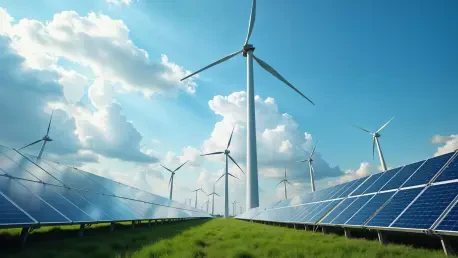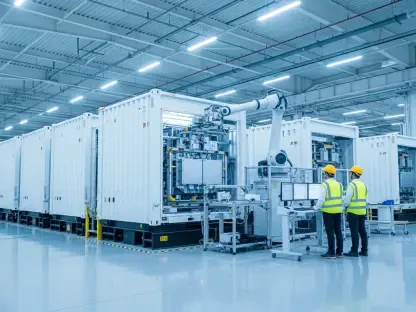Despite common associations with urban regions driving technological innovation, a remarkable shift is occurring in rural America, particularly in states like South Dakota. These regions are rapidly becoming leaders in renewable energy production, reshaping the national energy landscape. South Dakota’s ascent in this domain challenges traditional views that coastal or urban areas exclusively spearhead clean energy initiatives. This evolution underscores a broader movement where rural states, utilizing innate geographic benefits and pragmatic strategies, transition to renewable energy systems with significant economic and environmental advantages.
Natural Advantages Fueling the Transition
Harnessing Wind Power
South Dakota leverages its geographical features to spearhead wind energy production, contributing significantly to its renewable energy portfolio. The state’s flat terrain, steady winds, and expansive open landscapes create an optimal setting for wind farms, allowing wind power to account for over half of the state’s electricity generation. This strategic focus on wind energy has significantly reduced carbon emissions, estimated at over 10 million metric tons annually, roughly equivalent to removing 2.2 million cars from the roads. Since 2019, the state has seen a substantial increase in wind energy production. Currently, South Dakota boasts 29 extensive wind initiatives that supply electricity to more than 2 million homes, surpassing the number of households within its borders.
Supplementing with Hydropower
In addition to wind power, hydroelectric energy is a vital component of South Dakota’s renewable energy matrix, contributing approximately 21% of the state’s power needs by 2023. Harnessed primarily from the Missouri River’s major dams, hydropower provides a stable electricity source. Despite certain environmental trade-offs, such as the reduction of cottonwood trees affecting wildlife habitats, hydropower remains considerably more eco-friendly than fossil fuels. Its implementation demonstrates South Dakota’s balanced approach to renewable energy, where economic and ecological factors are carefully weighed. This strategic use of diverse energy sources helps South Dakota achieve a sustainable and robust energy framework that supports its long-term energy independence goals.
Solar Energy’s Growing Role
Increasing Solar Capacity
Though solar energy has historically played a minor role in South Dakota’s energy production, its prominence is swiftly increasing. Technological advancements and cost reductions have propelled solar generation upward, visible in its expansion from producing a mere 4 gigawatt hours (GWh) in 2022 to an impressive 346 GWh by 2024. This growth reflects a maturing sector within South Dakota’s renewable energy landscape, with solar power now capable of providing electricity for approximately 35,000 U.S. homes. As solar technology continues to improve in efficiency and affordability, South Dakota’s solar energy growth is expected to keep pace, further diversifying its renewable energy portfolio and reducing reliance on fossil fuels.
Economic Benefits of Solar Expansion
The burgeoning solar sector in South Dakota not only complements existing renewable efforts but also generates substantial economic benefits for local communities. The installation and maintenance of solar infrastructure create jobs in construction, electrical engineering, and other related fields. This job creation boosts local economies, fostering growth and providing new opportunities for residents. In addition to job generation, investments in solar energy projects attract tax incentives and promote infrastructure development. These financial benefits reverberate across communities, enhancing their resilience and stability while emphasizing sustainable energy independence as an achievable objective.
The Broader Impact on Rural Communities
Empowering Local Economies
The renewable energy shift in South Dakota serves as a blueprint for empowering other rural areas by transforming localized energy production and distribution. Historically dependent on centralized power generation, rural communities often faced challenges in managing energy distribution, pricing, and availability. Transitioning to renewable energy sources democratizes these aspects, granting landowners the ability to generate power for their communities. This newfound independence not only fortifies local economies by minimizing transmission losses but also ensures that financial returns from energy production stay within the community, offering direct economic incentives to residents and smaller institutions.
Enhancing Resilience and Stability
Adapting renewable energy technologies enhances the overall resilience and stability of rural communities in times of crisis. As climate change results in more frequent and severe weather events, integrating renewable energy systems with advanced battery storage technologies ensures consistent power supply to critical facilities like hospitals and agricultural operations even during grid failures. Advances in battery technology continue to improve storage capacity and efficiency, reducing costs and increasing reliability. This capability bolsters the long-term sustainability of rural infrastructure, ensuring that local communities remain robust and adaptable in the face of ongoing environmental and economic challenges.
A National Movement Towards Renewables
Increasing Renewable Output
Beyond South Dakota, a broader rural revolution in renewable energy is taking place across the United States. Data from 2025 reveals substantial growth in renewable energy production, with solar, wind, and geothermal power outputs tripling within a short span. States like Iowa, where more than 80% of electricity sales stem from renewables, exemplify this trend, alongside others such as Kansas, New Mexico, Wyoming, and Oklahoma. These states capitalize on natural resources to foster healthier and more sustainable energy systems, leveraging unique geographic advantages to drive this transition, thus challenging traditional energy production narratives centered on urban areas.
Integrating with Traditional Practices
Renewable energy is not just replacing but enhancing traditional industries in these regions. In agricultural fields, wind turbines coexist with grazing livestock and crops, while hydroelectric dams, preferably smaller ones, harness rivers for power without significantly disrupting ecosystems. This integration supports economic diversification in rural economies, providing steady revenue streams through landowner payments and consumer tax incentives. As renewables become ingrained in daily life, areas once considered technologically behind now emerge as leaders in the clean energy initiative, gaining bipartisan support and reshaping energy production in America.
Transformative Implications and Future Trajectories
Traditionally, urban areas have been seen as the primary hubs of technological progress, especially when it comes to energy innovations. However, an interesting trend is emerging in rural America, notably in places like South Dakota. These areas are gaining recognition as significant contributors to renewable energy production, altering the perception of the energy industry across the country. South Dakota’s rise to prominence in renewable energy challenges the conventional belief that clean energy is primarily driven by coastal or urban regions. This transformation highlights a larger movement where rural states are leveraging their unique geographic characteristics and adopting practical strategies to transition to renewable energy sources. These efforts not only boost the local economy but also offer substantial environmental benefits. By adopting solar, wind, and other sustainable energy solutions, these regions demonstrate how rural areas can be at the forefront of America’s renewable energy revolution.









